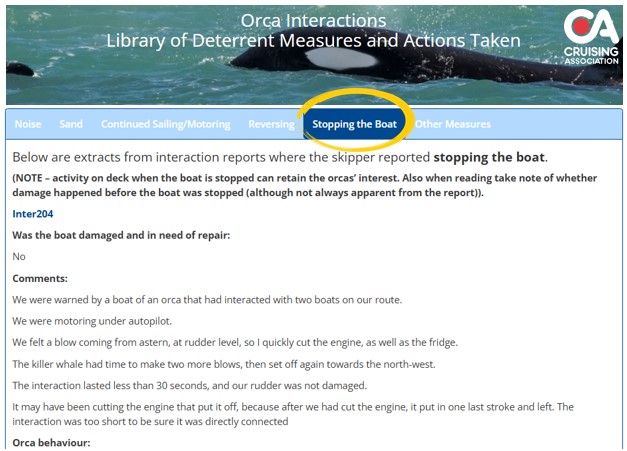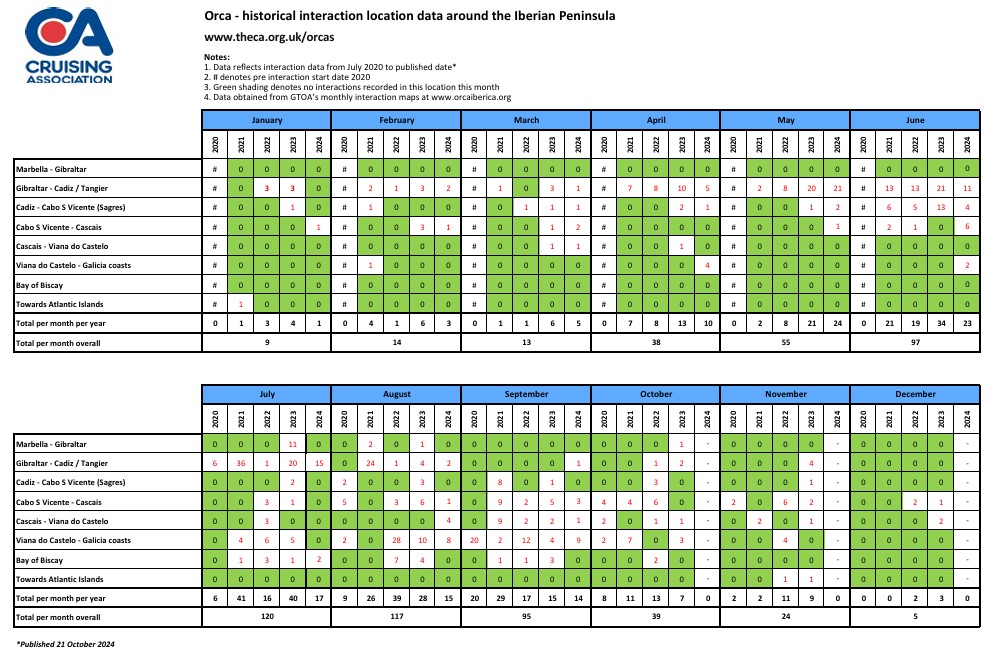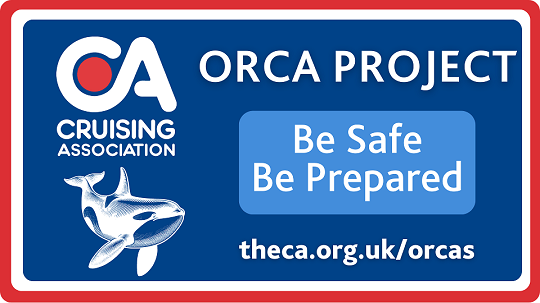The CA orca project team has released a significant update to the ‘Skippers’ Comments Library’, featuring over 40 new entries. A new category, ‘stopping the boat’, details the experience of skippers who stopped their vessel during an orca interaction.
2024 has been the fifth season of orca interactions and the ‘Interaction Location Data’ shows there has been some consistency in the location and time of interactions along the Atlantic coasts of Spain and Portugal. However, compared to previous seasons, this year saw fewer interactions before April, and a notable decline from June to August.
The ‘Skippers’ Comments Library’ and ‘‘Interaction Location Data’ table are useful resources for anyone planning to sail through the affected waters.
Skippers’ Comments Library
The library compiles comments extracted from the full interaction reports, categorising them into the different actions and measures that skippers have used to deter or end an interaction. This resource offers an accessible way to research the effectiveness of skipper actions based on first-hand accounts.
Skippers’ can view comments categorised into different deterrent measures taken: Reversing; Noise; Sand; Continued sailing/motoring; Stopping the boat; Other measures.
The latest comments also include a very informative entry, from a skipper who suffered a traumatic chase by orcas, which resulted in the yacht sinking shortly after rescue.

Interaction Location Data
The updated ‘Interaction Location Data’ table includes interactions up to the end of September 2024.
The analysis covers the Atlantic coasts of France, Portugal, Spain, and the Strait of Gibraltar from 2020 onwards. Compiled from Grupo Trabajo Orca Atlantica (GTOA) monthly data, the table provides an overview of interaction locations by year and month. However, even though it is currently the most comprehensive record, it should be noted that the GTOA maps cannot be regarded as 100% accurate.
The table shows that interactions peak between June and September, extending geographically from July through November. Monthly patterns vary, so while the table offers helpful insights, it is crucial to use up-to-date GTOA monthly maps and the CA’s recommended protocols when planning passages in affected areas. The table highlights in green where there have been no interactions in that section of coast by year and month.

Be Safe, Be Prepared
The CA emphasises the importance of risk awareness and preparation for potential orca encounters. Most yachts avoid interactions, but careful planning is essential:
- To avoid known danger zones, the CA recommends that skippers review this table when planning to sail through the specific areas of coastline affected by orca interactions and attacks.
- Visit the CA’s dedicated orca portal at www.theca.org.uk/orcas for resources in multiple languages, including the ,‘CA Checklist’, ‘Risk Reduction and Deterrent Measures’, ‘Interaction Location Data’ table and follow the recommended ‘Safety Protocol’ at www.theca.org.uk/orcas.
- Stay updated with the GTOA ‘traffic light’ risk map at www.orcaiberica.org, the GTOA’s interaction and sightings app GTOrcas, and the Orcinus app for current sightings. In addition, some social media sites such as Orca Attack Reports have reports of current sightings.
Submit a Report
The CA’s dedicated orca information and reporting portal provides a wide range of resources available in English, French, Portuguese and Spanish.
Please submit your reports on interactions or on uneventful passages through areas of interactions to assist the CA in developing its resources www.theca.org.uk/orcas.

13 November 2024
